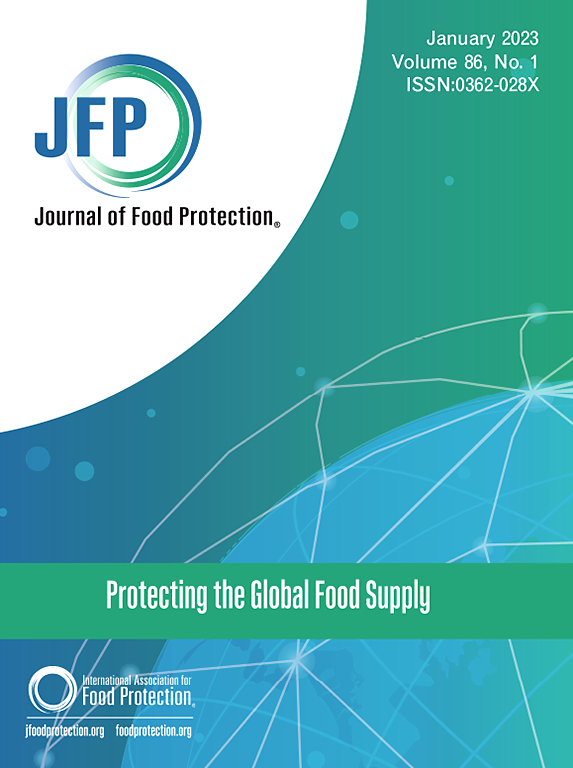A Critical Review of Parameters Relevant for Shiga Toxin-producing Escherichia coli and Listeria monocytogenes Risk Assessments of Leafy Greens
IF 2.1
4区 农林科学
Q3 BIOTECHNOLOGY & APPLIED MICROBIOLOGY
引用次数: 0
Abstract
In the past decade, several quantitative models and risk assessments for Shiga toxin-producing Escherichia coli (STEC) and Listeria monocytogenes have been developed to guide the management of these pathogens in fresh produce. However, there is a need to collect and critically review the parameters used to guide their potential reuse in future risk assessments. This review (i) identifies 11 and 7 recently published quantitative models and risk assessments for STEC and L. monocytogenes, respectively, in leafy greens, (ii) summarizes parameters, and (iii) reviews the underlying data sources or mathematical formulas used. A total of 70 unique key parameters (55 and 25 for STEC and L. monocytogenes, respectively, 10 shared) were extracted from the reviewed models across five supply chain stages, including: Preharvest, Harvest, Processing, Presentation to Consumer (Retail or Foodservice Locations), and Consumer Handling. Primary growth, secondary growth, and dose-response equations and parameters for STEC and L. monocytogenes were also extracted. Additional literature reviews were performed if (i) certain key parameters were based on a single or a few data sources or (ii) key parameters were identified in a supply chain stage for one pathogen, but missing from the other. The critical summaries of parameters presented here (i) provide a resource for future risk assessments, (ii) help define future data collection needs, and (iii) represent a starting point for similar reviews focusing on other produce commodities and pathogens.
绿叶蔬菜中产志贺毒素大肠杆菌和单核增生李斯特菌风险评估相关参数的综述。
在过去的十年中,一些志贺毒素产生大肠杆菌(STEC)和单核增生李斯特菌的定量模型和风险评估已经被开发出来,以指导新鲜农产品中这些病原体的管理。然而,有必要收集和严格审查用于指导它们在未来风险评估中可能再次使用的参数。本综述(i)分别确定了绿叶蔬菜中产大肠杆菌和单核增生乳杆菌的11个和7个最近发表的定量模型和风险评估,(ii)总结了参数,(iii)回顾了所使用的基础数据源或数学公式。共提取了80个关键参数(产大肠杆菌和单增乳杆菌分别为55个和25个,共有10个),这些参数来自5个供应链阶段的模型,包括:收获前、收获、加工、呈现给消费者(零售或餐饮服务地点)和消费者处理。提取了产志毒素大肠杆菌和单核增生乳杆菌的初代生长、次代生长、剂量反应方程和参数。如果(i)某些关键参数是基于单个或几个数据源,或(ii)在一种病原体的供应链阶段确定了关键参数,但在另一种病原体中缺少关键参数,则进行额外的文献综述。这里提出的关键参数摘要(i)为未来的风险评估提供了资源,(ii)有助于确定未来的数据收集需求,以及(iii)代表了以其他农产品和病原体为重点的类似审查的起点。
本文章由计算机程序翻译,如有差异,请以英文原文为准。
求助全文
约1分钟内获得全文
求助全文
来源期刊

Journal of food protection
工程技术-生物工程与应用微生物
CiteScore
4.20
自引率
5.00%
发文量
296
审稿时长
2.5 months
期刊介绍:
The Journal of Food Protection® (JFP) is an international, monthly scientific journal in the English language published by the International Association for Food Protection (IAFP). JFP publishes research and review articles on all aspects of food protection and safety. Major emphases of JFP are placed on studies dealing with:
Tracking, detecting (including traditional, molecular, and real-time), inactivating, and controlling food-related hazards, including microorganisms (including antibiotic resistance), microbial (mycotoxins, seafood toxins) and non-microbial toxins (heavy metals, pesticides, veterinary drug residues, migrants from food packaging, and processing contaminants), allergens and pests (insects, rodents) in human food, pet food and animal feed throughout the food chain;
Microbiological food quality and traditional/novel methods to assay microbiological food quality;
Prevention of food-related hazards and food spoilage through food preservatives and thermal/non-thermal processes, including process validation;
Food fermentations and food-related probiotics;
Safe food handling practices during pre-harvest, harvest, post-harvest, distribution and consumption, including food safety education for retailers, foodservice, and consumers;
Risk assessments for food-related hazards;
Economic impact of food-related hazards, foodborne illness, food loss, food spoilage, and adulterated foods;
Food fraud, food authentication, food defense, and foodborne disease outbreak investigations.
 求助内容:
求助内容: 应助结果提醒方式:
应助结果提醒方式:


